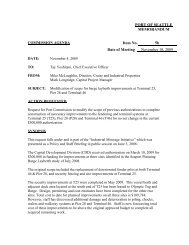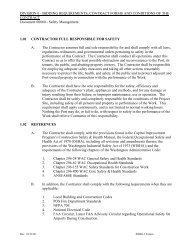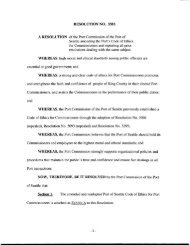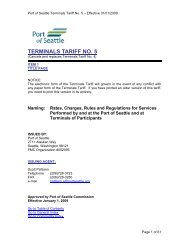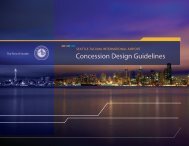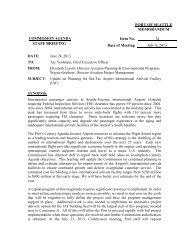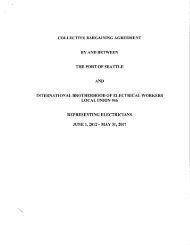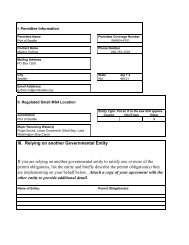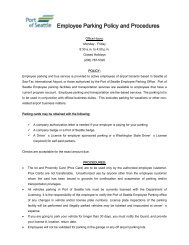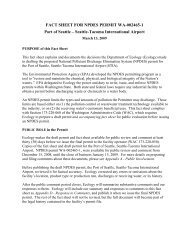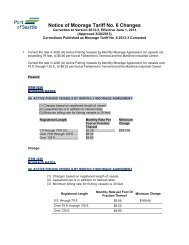7 MB PDF - Port of Seattle
7 MB PDF - Port of Seattle
7 MB PDF - Port of Seattle
You also want an ePaper? Increase the reach of your titles
YUMPU automatically turns print PDFs into web optimized ePapers that Google loves.
A I R M O V E M E N T A R EA( A M A )T R A I N I N G PROGRAMS T U D Y G UIDE
Airfield Tr a i n i n g P r o g r am S t u d y G u i d e P A G E 2
3 P A G E Airfield Tr a i n i n g P r o g r a m S t u d y G u i d eI N T R O D U C T I O NRecognizing the need to provide familiarization andtesting for non flight-crew personnel who areinvolved with operations on the airport, the <strong>Port</strong> <strong>of</strong><strong>Seattle</strong> (POS) has established the Airfield DriversTraining Program. This program presents guidelinesand procedures designed to enhance the safety andefficiency <strong>of</strong> all aircraft movement area operations.The POS Airfield Drivers Training Program consists<strong>of</strong> three program types; Runway (AMA), Taxiway(TXY), and Non-Movement Area. Each <strong>of</strong> theseprograms is designed to provide the appropriate level<strong>of</strong> training required to conduct operations in thoseareas. This manual covers the AirMovement Area or AMA.In addition, the implementation <strong>of</strong>this program is intended to assist inthe elimination <strong>of</strong> runwayincursions. A runway incursion isdefined as “any occurrence at anairport involving an aircraft,vehicle, person or object on theground, that creates a collisionhazard or results in loss <strong>of</strong>separation with an aircraft taking<strong>of</strong>f or intending to take<strong>of</strong>f, landing or intending toland.”Runway incursions can result in a collision with anaircraft. Such aircraft collisions, when occurring inthe runway environment, are <strong>of</strong>ten catastrophic. Anexample <strong>of</strong> this collision hazard is the accident whichinvolved two Boeing 747 aircraft which collided on arunway in the Canary Islands, resulting in the worstaccident in the history <strong>of</strong> commercial aviation, interms <strong>of</strong> lives lost in a single non-terrorist incident.In order to minimize the risk <strong>of</strong> a runway incursion, itis extremely important that all persons who conductair movement area operations have a thoroughunderstanding <strong>of</strong> the runway and airfield layout at<strong>Seattle</strong>-Tacoma International Airport (SEA) as wellas familiarity with applicable Air Traffic ControlTower (ATCT) procedures.airport movement areas at SEA. Successfulcompletion <strong>of</strong> the Airfield Drivers Training Programand Runway Testing (Check ride) process will resultin the issuance <strong>of</strong> a “RWY” Driver Identifier on thePOS Identification Badge. Following programimplementation, only individuals who havesuccessfully completed Airfield Drivers TrainingProgram’s for Runway, Taxiway, and Non-movementareas will be permitted to conduct aircraft movementarea operations at SEA. Any violation <strong>of</strong> the POSRules & Regulations, especially pertaining tomovement area operations may result in the loss <strong>of</strong>POS ID badge and/or retraining and testing.The objectives <strong>of</strong> this program are... To identify proper methods and procedures for the safe movement<strong>of</strong> aircraft at SEA. To distribute information which provides aircraft movement areaoperators with familiarization and knowledge <strong>of</strong> acceptableaircraft movement practices. To test for knowledge to ensure that all personnel who areinvolved with operations on the airport movement surfaces at SEAhave a basic understanding <strong>of</strong> acceptable procedures.This study guide contains basic information, whichshould be thoroughly understood by all persons whointend to operate on the Air Movement Area. Thisguide is divided into three sections: Section one contains information regardingproper aviation terminology, phraseology andcommunications on aviation VHF radioequipment. Section two contains information regardingmovement/non-movement areas and a map <strong>of</strong>these areas. Section three contains information specific toSEA, including the vehicle control line,surface markings, airfield signage andlighting.Participation in this program and successfulcompletion <strong>of</strong> a mandatory test is required for allpersonnel who are involved with operations on theS E C T I O N O NE
Airfield Tr a i n i n g P r o g r am S t u d y G u i d e P A G E 4S E C T I O N O NE Air Traffic Control Procedures andRadio PhraseologyIt is essential to safety that personnel responsible foroperations on all airport movement areas at SEA bethoroughly familiar with ATCT procedures and radiophraseology. Correct phraseology and radio techniqueshould be used in all communications with ATC. Use<strong>of</strong> correct radio techniques will reduce frequencycongestion, allow a more expeditious flow <strong>of</strong> aircraftmovements and reduce miscommunications.When using an aviation VHF radio, it is important tocommunicate in a clear and concise manner so thatATCT understands your transmission. Use <strong>of</strong> slang,CB or police jargon must be avoided. Transmissionsshould be brief yet complete enough to adequatelyconvey the message to ATCT.ICAO Phonetic AlphabetTo minimize confusion between similar soundingletters, a standardized aviation phonetic alphabet hasbeen adopted for use by the International CivilAviation Organization (ICAO). ATCT will use thisalphabet during all transmissions to identify taxiways.The phonetic alphabet is shown below, and must bememorized:ICAO Phonetic AlphabetA Alfa N NovemberB Bravo O OscarC Charlie P PapaD Delta Q QuebecE Echo R RomeoF Foxtrot S SierraG Golf T TangoH Hotel U UniformI India V VictorJ Juliett W WhiskeyK Kilo X X-RayL Lima Y YankeeM Mike Z ZuluSEA-ATC FrequenciesRamp North 126.87 Ramp South 122.27Ground Control 121.70 or 118.35Tower (Local Control) 119.90 or 120.95Alternate 126.25Weather & Airport Information 118.00 PhraseologyUse <strong>of</strong> correct radio phraseology enhances safety andsaves time. Listed below are examples <strong>of</strong> some <strong>of</strong> themost common terms:ACKNOWLEDGE - Let me know that you havereceived my message.ADVISE INTENTIONS - Tell me what you plan todo.AFFIRMATIVE - Yes.CONFIRM - My version is…is that correct?CORRECTION - An error has been made in thetransmission and the correct version follows.GO AHEAD - Proceed with your message. Not to beused for any other purpose.HOLD - Stop where you are.HOLD SHORT OF… - Proceed to, but stop beforereaching a specific point.NEGATIVE - No, or permission not granted, or that isnot correct.PROCEED - You are authorized to begin or continuemoving.READ BACK - Repeat my message back to me.ROGER - I have received all <strong>of</strong> your lasttransmission. It should not be used to answer aquestion requiring a yes or a no answer.SAY AGAIN - Used to request a repeat <strong>of</strong> the lasttransmission. Usually specifies transmission orportion there<strong>of</strong> not understood or received.STAND BY - Means the controller or pilot must pausefor a few seconds, usually to attend to other duties <strong>of</strong> ahigher priority. Also means to wait as in “stand by forclearance.” If the delay is lengthy, the caller shouldreestablish contact.UNABLE - Indicates inability to comply with aspecific instruction, request, or clearance.VERIFY - Request confirmation <strong>of</strong> information; e.g.“verify cleared to cross runway one six left.”WILCO - I have received your message, understandit, and will comply with it.
5 P A G E Airfield Tr a i n i n g P r o g r a m S t u d y G u i d e ATCT Light Gun SignalsIn the event that communications are lost with ATCT,the controllers have light guns to signal aircraft andvehicles.STEADY GREENCleared to cross, proceed or goFLASHING GREENCleared for taxiSTEADY REDSTOPFLASHING REDClear the taxiway/runwayFLASHING WHITEReturn to starting point on airportALTERNATING RED/GREENExercise extreme caution If not on a movement area, DO NOTENTER. If on a runway, continue across but DO NOTCROSS ANOTHER RUNWAY. Watch for light gun signals or wait for anescort. Then, verify that the microphone selectorswitch is set to the proper radio. This willhelp reduce the number <strong>of</strong> instances where onefrequency is being monitored and another isbeing inadvertently transmitted on. Prior to transmitting, consider what you aregoing to say, and use the following: WHO you are calling WHO you are WHERE you are on the airport WHAT you are requesting, orintending to doHere is a detailed example:Your job requires you to operate on the Cascade Roadin between taxiway’s DELTA (D) and HOTEL (H) onthe north end <strong>of</strong> the airport. The airport is in southflow meaning the runways in use are 16 Left, 16Center, and 16 Right. You first proceed on the NON-MOVEMENT area down to Cargo Area 1. While youremain on the NON-MOVEMENT area you contact<strong>Seattle</strong> Ground Control and request access...WHO you are callingWHO you are callingWHO WHO you areWHERE you are on the airportWHAT you you are are requesting, or intending to to do do Transmitting on Aviation VHFFrequenciesThere are a few simple measures, which should betaken before transmitting on the aviation VHF radio: Prior to transmitting, the radio should first bechecked by verifying that the correctfrequency has been selected. Next, the frequency should be monitored todetermine that no one else is transmitting orwaiting for a read-back. Monitoring thefrequency prior to transmitting helps inestablishing a mental picture <strong>of</strong> the currentsituation, commonly called situationalawareness. This procedure will also eliminateinstances <strong>of</strong> transmitting at the same time assomeone else.<strong>Seattle</strong> Ground, Foxtrot 99 - (wait for a response)Foxtrot 99, <strong>Seattle</strong> Ground…<strong>Seattle</strong> Ground, Foxtrot 99 is at CARGO 1 wouldlike to conduct operations on the Cascade Roadbetween taxiways Delta (D) and Hotel (H)referencing aircraft.Foxtrot 99, <strong>Seattle</strong> Ground, you are clearedto cross taxiways ALPHA (A) and BRAVO(B); hold short <strong>of</strong> Runway 16L (Left) attaxiway DELTA (D), and contact Tower.<strong>Seattle</strong> Ground, Foxtrot 99 is cleared to crosstaxiway ALPHA (A) and BRAVO (B), hold short<strong>of</strong> Runway 16L (LEFT) at DELTA (D) and contactTower.It is very important that you listen closely and followthe controller’s instructions. In the above exampleyou have a need to cross active taxiways ALPHA andBRAVO and an active runway 16L. You are clearedto cross the active taxiways, but not cleared to crossthe runway. You must hold short <strong>of</strong> runway 16L andcontact tower once you have reached the hold shortline on taxiway DELTA in order to proceed further.If in doubt, ASK QUESTIONS!
Airfield Tr a i n i n g P r o g r am S t u d y G u i d e P A G E 6General Rules to Follow While on the Airmovement area (AMA)Ensure that all available pertinent informationregarding airport construction, movement areaclosures and applicable VHF frequencies has beenreviewed. Know where you are, where you aregoing, and how to get there. Is operation on the movement area absolutelynecessary? Can the operation be delayed until a less busytime? Listen before you transmit. When you areready to transmit, pause, listen, and make surethe frequency is clear.S E C T I O N T WO Movement AreasMovement areas are defined as the runways,taxiways, and other areas <strong>of</strong> the airport which areutilized for the taxiing, take<strong>of</strong>f, and landing <strong>of</strong>aircraft, exclusive <strong>of</strong> loading ramps and parking areas.Here at SEA, specific approval for entry onto themovement area must be obtained from ATCT.Identified below are the types <strong>of</strong> movement areasfound on the airfield at SEA. Runway – A defined rectangular surface onan airport prepared or suitable for the landingor take<strong>of</strong>f <strong>of</strong> airplanes. Use the correct radio technique andphraseology. Read back ATCT instructionsbefore proceeding and read back all hold shortand runway crossing instructions verbatim. Maintain a “sterile cockpit”. Do not becomeabsorbed in unrelated tasks or non-essentialconversations while on movement areas. Look in all directions before proceeding ontothe movement area and then move in anexpeditious manner. Report when <strong>of</strong>f the movement area. Be alert to the sounds or the lack <strong>of</strong> sounds inyour receiver. Check your volume, recheckyour frequency, and make sure that yourmicrophone is not stuck in the transmitposition. If you are unsure <strong>of</strong> your position on theairfield, stop and ask for assistance. Continuously monitor the appropriate ATCTfrequency and acknowledge all transmissions. Ensure that you fully understand yourinstructions. If you are unsure, ask forclarification and do not move until youcompletely understand. Report any deteriorating/confusing airfieldsigns, surface markings or lighting to SEAAirfield Operations, or FAA at an appropriatetime. Taxiway – A defined path established for thetaxiing <strong>of</strong> aircraft from one part <strong>of</strong> an airportto another.Movement areas are shown on the mapon the next page in RED Non-Movement AreasNon-movement areas are defined as the taxilanes andapron/ramp areas not under the control <strong>of</strong> ATCT, butAircraft Operations and some vehicle operationsrequire SEA Ramp Tower Authorization. At Sea-Tacthe non-movement area is controlled by <strong>Seattle</strong> RampTower.Identified below are the types <strong>of</strong> non-movement areasfound on the airfield at SEA. Taxilane – The portion <strong>of</strong> the aircraft parkingarea used for access between taxiways andaircraft parking positions. Apron/Ramp – A defined area on an airportintended to accommodate aircraft for purposes<strong>of</strong> loading or unloading passengers, mail orcargo, refueling, parking or maintenance.Non-movement areas are shown on theAlways Maintain YourSituational Awareness
REAMOVEMENT AREAREAmapnextin7 P A G E Airfield Tr a i n i n g P r o g r a m S t u d y G u i d e<strong>Seattle</strong> Ramp Tower:Controls Non-Movement Area<strong>Seattle</strong> Air Traffic Control Tower:Controls Movement AreaNON ON-MOVEMENTOVEMENT AREANON ON-MOVEMENTOVEMENT AREAon thepageBlue= Vehicle Control Line
Airfield Tr a i n i n g P r o g r am S t u d y G u i d e P A G E 8S E C T I O N T WO - M O V E M E N T A R E A TaxiwaysSEA has three North-South oriented taxiways. These are Alpha (A), Bravo (B) and Tango (T). Taxiway Alpha(A) begins north <strong>of</strong> the North Satellite and continues to the North Apron where it meets with Taxiway Delta(D). Taxiway Bravo (B) is east and parallel to the full length <strong>of</strong> 16 Left (L)/34 Right (R). Taxiway Tango (T)is west and full length <strong>of</strong> 16 Center (C). All taxiways are in the movement area and require ATCT clearancebefore entering. NEVER ENTER onto a taxiway without clearance even if you think it is safe or clear to do so.SEA also has many inter-connecting taxiways. These are Charlie (C), Delta (D), Echo (E), Foxtrot (F), Golf(G), Hotel (H), Juliett (J), Kilo (K), Lima (L), Mike (M), November (N), Papa (P), Quebec (Q), and Sierra (S).These taxiways are sequenced alphabetically from the north, and may cross both runways, connecting the westside <strong>of</strong> the airfield to the east (terminal and ramp areas). In addition the new third runway has two newtaxiways, Romeo (R) located on the far south <strong>of</strong> Runway 16R/34L and Zulu (Z) located on the north end <strong>of</strong>Runway 16R/34L
9 P A G E Airfield Tr a i n i n g P r o g r a m S t u d y G u i d e Taxiway Markings & LightingTaxiway painted surface markings are yellow with a black background. Taxiway painted surface markingsincludes a yellow centerline and double black edgelines. Taxiways have green centerline lights or reflectorsand/or blue edge lights or reflectors.In-pavement runway guard lights are amber and parallel to and in front <strong>of</strong> the runway holding position line.Elevated runway guard lights (amber, alternating flashing lights) are placed to the sides <strong>of</strong> a runway/taxiwayintersection adjacent to the painted hold lines.
Airfield Tr a i n i n g P r o g r am S t u d y G u i d e P A G E 10S E C T I O N T WO - M O V E M E N T A R E A RunwaysRunway designations are based on a runway’s magnetic heading, using the 360-degree compass system.Runways may be used in two (opposite) directions, resulting in two runway designations, which are 180 degreesdifferent from one another.Therefore, a runway which is designated asrunway 18/36 would be oriented in the north/south direction, with compass headings <strong>of</strong> 180and 360 degrees. If aircraft were conductingtake-<strong>of</strong>f <strong>of</strong> landing operations to the north, therunway in use would be designated as runway36. If the same runway were being used byaircraft conducting take-<strong>of</strong>f or landingoperations to the south, then the same runwaywould be designated as runway 18. If there ismore than one parallel runway, a letter is addedto differentiate the left (L), right (R) or center(C) runway.At SEA, the runways are oriented in a north/south direction with designations <strong>of</strong> 16R/34Lfor the new western most third runway,16C/34C for the center runway, and 16L/34Rfor the eastern most runway. You MUSTNEVER enter a runway without prior ATCTclearance.YOU MUST NEVERENTER A MOVEMENTAREA WITHOUTPRIOR AIR TRAFFICCONTROLCLEARANCE!
11 P A G E Airfield Tr a i n i n g P r o g r a m S t u d y G u i d e Runway Markings & LightingRunway painted surface markings are white with a black background. Runway painted surface markingsinclude centerline stripes, edge stripes, threshold/touchdown bars, and runway designation markings.Runway edge lighting is white, and then it changes to amber at 2000 feet from the end <strong>of</strong> the runway. Runwaytouchdown zone lighting is white. Runway centerline lighting is white, and then changes to alternating red andwhite at 3000 feet remaining, and then finally red at 1000 feet from the end <strong>of</strong> the runway.Note: The lights in this photo appear amber or red, however they are actually white.W A Y S T O P R E V E N T I N C U R S I O N SSee The Big PictureUnderstand Signs, Lights, & MarkingsTransmit ClearlyListen, Listen, ListenKnow Your LocationKnow What Is Going On Around YouNEVER ASSUMEASK FOR HELP WHEN NEEDEDFollow all ATCT & RAMP Procedures
Airfield Tr a i n i n g P r o g r am S t u d y G u i d e P A G E 12S E C T I O N T H R E E - M O V E M E N T /NON M O V E M E N T A R E A S Pink Spots (GPM’s)Geographic position markings (pink spots) are located on various Taxiways/Taxilanes and are accompanied byclearance bars (three amber in-pavement lights) and an intermediate holding position markings (dashed yellowline with a black background). Some <strong>of</strong> the GPM’s are in Movement areas, while others are in Non-Movement areas. Having knowledge <strong>of</strong> the pink spots and their locations can assist you with your position atthe airport. It also makes for an easy way to communicate your location to ATCT and Ramp Tower at anytime,especially during SMGCS (Surface Movement Guidance & Control System - low visibility) times. Green Start BoxesThe Start Boxes associated/paired with Geographic Position Markings (GPM) at the entrance to the ramps areGREEN in color. Additionally, boxes 50 , 90 & 100, located on Taxilane WHISKEY (W) have also beenpainted GREEN. The intention <strong>of</strong> this is to draw a visual distinction between the Start Box and the nearbyGPM. These green start boxes are in the NON-MOVEMENT AREA.
13 P A G E Airfield Tr a i n i n g P r o g r a m S t u d y G u i d eS E C T I O N T H R E E - N ON- M O V E M E N T A R E A Taxilane “WHISKEY”Taxilane WHISKEY (W) runs parallel to the drive line on the east side <strong>of</strong> the airport from the just beyond theNorth Satellite down to Cargo 7. This taxilane is differentiated from taxiway BRAVO (B) by its color; a yellowcenterline with lime-green side stripes or background (See photo below). The primary function <strong>of</strong> taxilaneWHISKEY (W) is to support opposite direction <strong>of</strong> air traffic from taxiway BRAVO (B). Taxilane WHISKEY(W) is controlled by the RAMP TOWER. TaxilanesTaxilanes, also referred to as alleys or alleyways, are situated at various locations at SEA, and have yellowcenterlines with black backgrounds. Taxilanes are in the passenger terminal areas around the north and southsatellites and in the cargo areas. Taxilanes at SEA are non-movement areas.
Airfield Tr a i n i n g P r o g r am S t u d y G u i d e P A G E 14S E C T I O N T H R E E - N ON- M O V E M E N T A R E A Vehicle Control LinesThe Vehicle Control Line is a solid RED line with a white background or border. This line represents theboundary area between movement and non-movement areas. Vehicles and Pedestrians are NOT ALLOWEDto cross this line without PRIOR authorization from SEA ATCT. If you cross over this line without beingauthorized it is then a taxiway incursion and serious penalties can result, not to mention potential interferencewith aircraft operations. When you see this line, always stop, think, and make sure you have prior clearance tocross it!
15 P A G E Airfield Tr a i n i n g P r o g r a m S t u d y G u i d e Ramp/Apron AreasRamp/Apron areas are maintained by the individual airline, ground handling companies, or the POS. Surfacemarkings and lighting, when present, will be similar to that <strong>of</strong> a taxilane. Ramps/Aprons at SEA are also nonmovementareas. Object Free LineThe Object Free Line is a white dashed line. This line is commonly found around the RAMP areas. Whenplacing ground support equipment, vehicles, cargo, and other materials necessary for aircraft support, theseitems MUST never extend beyond this white line.
Airfield Tr a i n i n g P r o g r am S t u d y G u i d e P A G E 16S E C T I O N T H R E E - S I G N S A N D M A R K I N G S Airfield Signs and Surface MarkingsAirfield signs, surface markings, and lighting are visual aids designed to guide operations on movement areas.The colors and sizes <strong>of</strong> signs and painted surface markings are significant.Mandatory instruction signs have a red background with white lettering. These signs denote the entrance to arunway, approach area, or critical area.Location signs have a black background with yellow lettering and a yellow border. Location signs identifymovement areas and are installed so as to be highly visible, usually on the left side <strong>of</strong> the movement areas.Location signs are <strong>of</strong>ten combined with other types <strong>of</strong> signs. Direction signs have a yellow background withblack lettering and arrows. Direction signs are placed before an intersection to identify the intersectingtaxiways. The arrows indicate the directions <strong>of</strong> the taxiways that lead out from the intersection. Informationsigns have a yellow background with black lettering. Information signs provide various types <strong>of</strong> advisories.
17 P A G E Airfield Tr a i n i n g P r o g r a m S t u d y G u i d e Surface MarkingsAt the intersection where a taxiway meets a runway, painted surface markings called hold lines (holdingposition markings) are installed. Hold lines consist <strong>of</strong> two solid yellow lines followed by two segmented yellowlines. Operators must hold (STOP) on the side which has the two SOLID bars. This is also the location at theintersection where the mandatory instruction sign identifying the runway is placed. ATCT authorization isrequired to proceed beyond the hold lines.Instrument Landing System (ILS) hold lines (ILS holding position markings) are painted onto thesurface at locations where it is necessary to keep aircraft and vehicles on the ground from interfering with thesignals transmitted from the ILS antennas. When ILS approaches are in progress, during periods <strong>of</strong> lowvisibility,operators may be instructed by ATCT to “hold short <strong>of</strong> the ILS critical area”. The ILS hold short arearesembles a ladder, and ATCT might call it the ILS LADDER.
P o r t o f S e a t t l e A i r p o r t O p e r a t i o n sP O B O X 6 8 7 2 7S e a t t l e , WA 9 8 1 6 8206.248.6862D e s i g n e r : R i c h a r d M o s l e rA u t h o r s : M i c h e l l e M o s h n e r , R i c h a r d M o s l e rC o n s u l t a n t s : P a t r i c k C l a n c y , S a r a h D e m o r y , R o b e r t K i k i l l u s ,M i c h e l l e M o s h n e r , R a v e e n a P i l l a y , E d w a r d F r i e d m a n , a n d m a n y o t h e r s2009 <strong>Port</strong> <strong>of</strong> <strong>Seattle</strong>Date revised 06.11.09Rev: 2010-02-03



